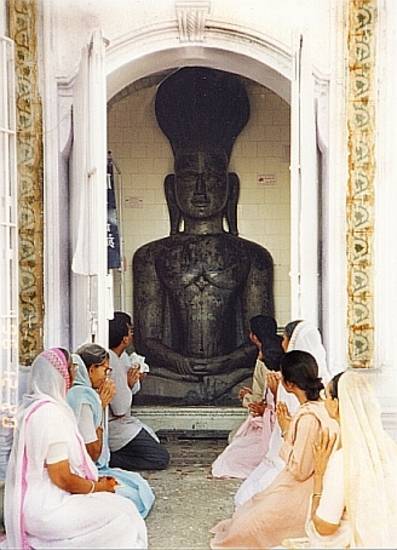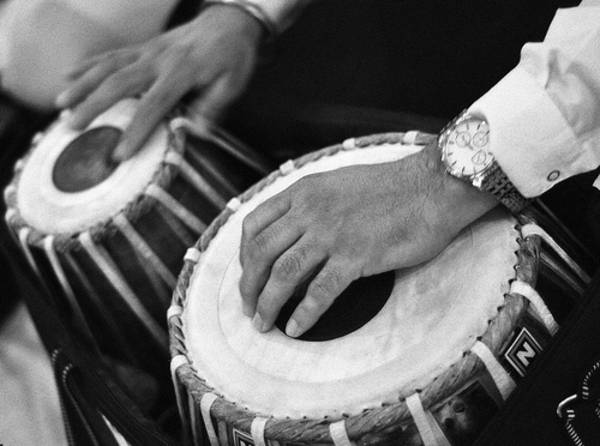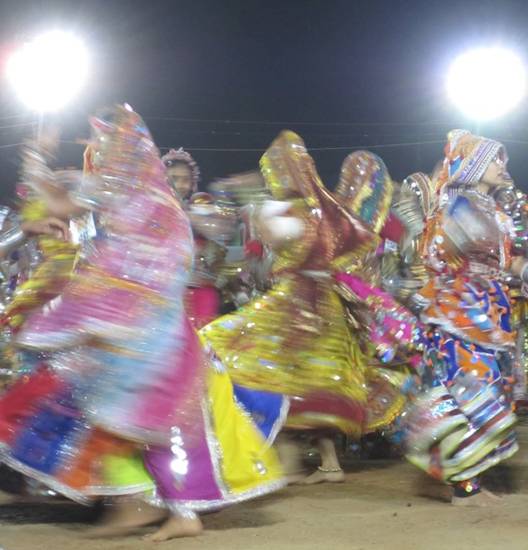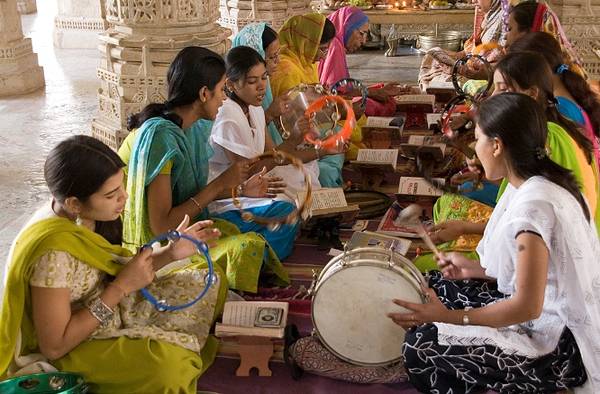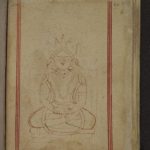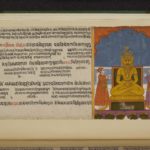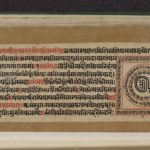Article: Songs of devotion
Known as stavan or, in Hindi, bhajan, Jain hymns are composed and performed to praise the Jinas. Written in every language Jains have used, the predominant pada form reflects Jain involvement in Indian poetics and in the bhakti devotional movement more commonly associated with Hinduism.
Musically, Jain hymns can be grouped into the folk genres of devotional music in western India, such as Gujarāti rās-garbā and Rājasthāni folk music. More modern musical influences such as Bollywood film melodies are also clear, although the Jain style of singing hymns descends from traditional popular music.
As a central element of Jain worship, hymns form part of the morning ritual and are essential to most religious ceremonies, such as offering alms to a mendicant. Religious songs are especially important in public festivals and celebrations, such as the ordination of a monk or nun, or the completion of a fast. Hymns are sung solo and by mixed groups or male- or female-only choirs in temples and domestic settings, in public and private worship.
In all settings and occasions, Jain hymns aim to help individual souls advance along the cycle of rebirth. The hymns most frequently use the rasa of peace to create a mood of tranquillity among listeners and performers, fostering the meditation necessary for spiritual development.
Development of Jain hymns
Both main Jain sects agree that Jain hymns have a mythological beginning, stemming from when the king of the gods first praised the qualities of the Jinas. They believe that the daily hymn Sakra Stavan is based on this exaltation, which lists many images that help to form basic concepts of the Jina.
Although Jains have drawn on elements of the Hindu tradition of bhakti poetry in developing religious songs, they have adapted it to their philosophical ideas and practices. Jain hymns stress praise of the Jinas and extol their virtues.
Origin of Jain hymns
According to both Śvetāmbara and Digambara mythological traditions, hymns in Jain worship derive from praise given to the Jinas by Śakra, the king of the gods. This has become the Śakra Stavan, recited as part of the daily morning prayers. Memorised by all observant Jains, the text provides a list of images for Jain devotional literature while also giving it a mythological pedigree. Many of the epithets for Jinas in hymns come from this and other texts recited as part of the morning worship. They are memorised by many Jains more often than any other long text so these images create the basis of understanding what a Jina is and what a Jina can do.
Influence of Hindu bhakti
Jains have participated fully in the bhakti devotional movement but they have done so in ways that support their religious beliefs. Jain writers have composed thousands of devotional hymns, the most popular of which are performed daily.
Jain hymns draw on bhakti poetry aesthetics in language, metaphor and poetic metre and form discussed below in turn. However, these hymns differ from the standard trope of Hindu bhakti poetry, which focuses on passionate attachment to a god and cajoling of the divinity for favours. Instead, Jains emphasise the cultivation of spiritual progress and praise of the Jinas’ virtues.
Jain involvement in the bhakti tradition parallels the developments in bhakti literature more broadly. Jains have used the same poetic forms and devices as their Hindu counterparts. In addition, Jain bhakti poetry often shares metaphors with Hindu bhakti verse. For example, hymns addressed to the Jina Neminātha or Lord Nemi share with hymns addressed to the Hindu god Kṛṣṇa the focus on romantic love and the suffering of separation.
Hymns that are still commonly performed to this day include those by the great Digambara writers:
- Daulatrām (1789–1866)
- Dyānatrāy (1676–1726)
- Budhjan (circa 1763–circa 1838)
- Bhādardās (circa 1700–circa 1765).
Popular religious songs for the Śvetāmbara sect include those by:
- Ānandaghan (1603–1673)
- Udayratna (circa 1692–circa 1743)
- Jñānvimal-sūri (1645–1713).
Hymns
In general, the Sanskrit word stavan refers to ‘hymn’. Sometimes called bhajan or pada, Jain hymns are devotional songs usually sung in Gujarāti, Hindi, Mārvāḍī, and Braj Bhāṣā.
There are several other words that have been translated as ‘hymns’ within the Jain tradition but nowadays these terms usually describe recitations.Contemporary Jains use stavan when they mean religious song.
Jains customarily include several types of songs – gīt – in collections of hymns:
- fasting songs – tapasya gīt
- mendicant welcome songs – sādhu svāgatam gīt or gahuli gīt
- ordination songs – dīkṣā gīt
- auction songs – boli gīt
- veil songs – cunḍaḍī gīt.
Other kinds of ‘hymns’
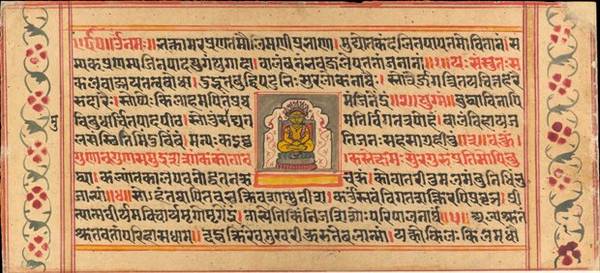
Bhaktāmara-stotra opening
Image by British Library © CC0 1.0 (Creative Commons Public Domain)
Several other words have often been translated as ‘hymns’ and, confusingly, each of these terms has been used differently among Jains. Though sometimes used instead of stavan, these other genres now refer chiefly to recitations rather than sung hymns.
Sajjhāys are narrative devotional poems recited or sung as part of the rite of confession or as a form of devotional study.
A stotra is a prayer to be recited, not sung. There are certain stotra that are widely read and recited, most notably the Bhaktāmara-stotra.
A stuti is an old prayer usually in Prakrit or Apabhraṁśa, which can be chanted or recited.
A sutra or verse is usually a ‘fixed’ text, which the reciter cannot change. Examples include the Kalpa-sūtra and the Khamāsamāṇo-sūtra, which are often recited from memory.
Languages and poetics
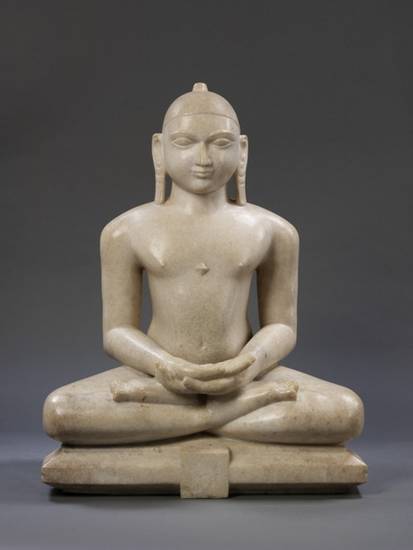
Digambara sculpture of Candraprabha
Image by Gift of Sir Michael Sadler K.C.S.I., C.B. © Victoria and Albert Museum, London
Jain hymns are written in every language that Jains have used. The bulk of medieval and modern hymns performed today are written in Gujarāti and Hindi, including dialects of Hindi such as Mārvāḍī. There are also substantial numbers of hymns written in Marathi and Kannada. The older hymn genres include hymns written in Prakrit, Sanskrit and Tamil.
Jain hymns are heavily influenced by Sanskritic conventions of verse. Their poetics draw on two major traditions within Sanskrit poetics – rasa and alaṅkār. Rasa poetics is a theory of mood focusing on a poem’s creation of mood. The most significant one in Jain religious songs is the rasa of peace or calmness. The alaṅkār, or ornament, devices include both metaphors and the music of the poetry.
Jain religious songs most frequently follow the pada verse form. Although this form is associated with the bhakti devotional movement in Hinduism, Jain writers adopted pada for their own religion.
Inherited as part of pada poetry, the moraic metre is generally used in Jain hymns. This musical metre counts the lines of the song in one of two methods. Either the heavy and light beats can be counted, or the stressed and unstressed beats in the rhythm of the language.
Evocation of mood – rasa
Writers of Jain hymns try to conjure up a feeling to heighten the devotional sentiments of their work. A hymn’s rasa – creation of mood – usually aims to arouse certain emotions in the subject of the song. However, Jain hymns do not hope to evoke any feelings in the Jinas who are their subject. Jinas are detached from earthly concerns and thus do not feel moods. Clearly, therefore, the poetry of Jain devotional songs is intended to create sentiments in the singers and listeners.
There are eight rasas outlined in Bharata’s Nāṭyaśāstra:
- love – śṛṅgāra
- humour – hāsya
- pity or compassion – kāruṇa
- anger – raudra
- heroism – vīra
- terror – bhayānaka
- disgust – bībhatsa
- wonder – adbhuta.
Udbhaṭa was a rasa theory author of the early ninth century who added the ninth rasa of calm or peace – śānta. This became the mood that many hymn poetics aim to create. While there are devotional hymn lyrics that seem designed to achieve the rasa of love or the rasa of compassion, most hymns employ the rasa of peace.
Therefore the singer and listeners might hope to attain calmness through the use of śāntarās or the sentiment of peace in the hymn. This would help them meditate, a duty for all Jains and a vital part of spiritual progress.
Lyrical ornaments – alaṅkār
Jain hymns use traditional Sanskritic methods of ornament – alaṅkār – to help produce attractive, meaningful lyrics. These techniques use both the:
- meaning of words – for example, simile and metaphor
- the sounds of words, such as rhyme, alliteration and repetition. These latter aid the musicality of the words and the hymn in general.
The focus of the alaṅkār school of poetics is simile. The most widespread simile in the hymn is the rūpaka – identification of image and subject. For example, the qualities of the Jina can be compared to something that people understand as more everyday experience. An example of this form of simile occurs in the contemporary hymn Money or God:
Money is dull stone and God is shining gold,
Tell who you love, Money or God?
In this hymn, the Jina is compared to gold – a shining, pure and valuable thing – and contrasted with stone – a mundane substance but one used to make the very images in front of which the Jains are singing.
Jain devotional songs also use śabda-alaṅkār – the ornaments of sound and word including alliteration, rhyme, metre and so on. These poetic ornaments create the effectiveness of the hymn as a song.
The poetic devices most frequently used in Jain religious songs are rhyme and alliteration.
Rhyme is heavily used partly because of the Sanskritic languages in which early Indian verse was composed. Jain hymns are generally written in Hindi and Gujarāti, which both use the grammar order subject—object—verb. This order makes rhyming at the end of lines easier. If the subject remains the same in number and gender, the verbs at the end of the line make them end with a rhyme over at least two syllables. An example, though there are hundreds, from Kesarīyā O Kesarīyā, a contemporary stavan:
Tara Gīto Hu Gāu, Manmandir Padharāvū
Tarī Mudrāo Vārī Jāū, Vārī Jāū
Jal Kalaśa Marāvū Snātra Vidhīye Karāvū
Mārā Antarnā Mel Dhoyarāū.
Alliteration is the most common poetic device after end rhyming. It is utilised in two ways, when:
- initial consonants or vowels are repeated
- different words with the same root are brought into play.
For example, repeated roots are used to create poetic impact in the well-loved hymn He Karuṇānā Karaṇārā:
He Karuṇānā Karaṇārā, Tārī Karuṇāno Koī Pār Nathī?
He Sankapanā Haraṇārā, Tārī Karuṇāno Koī Pār Nathī?
Me Pāp Kavyā Che Evā, Hu Bhūlyo Tārī Sevā
Mārī Bhulonā Bhūlanārā, Tārī Karuṇāno Koī Pār Nathī?
Form – pada verse
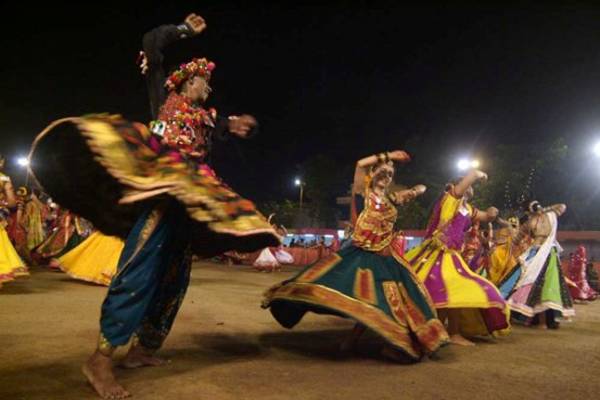
Rās-garbā dance
Image by Hardik jadeja © CC BY 3.0
Jain hymns are part of the bhakti devotional poetry movement of India and share its central formal aspects. Jains use the pada form for most of their hymns.
The pada usually have four to seven rhyming couplets and use the first or second line of the whole poem as a refrain throughout. Following Jayadeva and the South Indian bhakti poetry style which influenced Jayadeva, padas usually have the poet’s name in the last line. However, many of the newer religious songs do not include the poet’s name at the end.
Garbā poetry, which accompanies garbā dance at Navrātrī, is also in pada form.
The popular hymns performed in Digambara temples called Darśan Paths are also in the pada form. This shows how both major Jain sects have adopted this popular religious poetic form.
Metre – moraic metre
The metre of Jain hymns is that used in the conventions of the verse form of pada. Poetry in Prakrit did not measure cadence by pure syllables, but by moraic metre based on the weight of the syllables. Traditional moraic metre was adopted by writers of the pada form. Since this poetic form is the most common form of Jain hymns, most Jain religious songs use moraic metre.
Rather than having a set number of syllables in the line, in moraic metre the metre is determined in one of two manners.
One method is to count the number of long or heavy beats. The second way is to count the heavy beats as two and the light beats as one to add up to a number of total beats that is repeated in each line of the hymn.
Musical metre is also determined by the stressed and unstressed beats. However, these stresses depend on the placement of the note within the rhythm, not the type of syllable in the lyrics.
When the longer and stressed notes of the music are well matched by the heavy beats of the poetry, it results in smooth natural singing. Even so, this match of metres is not the primary factor when selecting a hymn repertoire. However, some women performers may consider this aspect when choosing their favourite solo hymn.
Musicality
The instrumentation and melodies used for Jain hymns reflect both their roots as a western Indian music tradition and the context in which they are performed.
The musical instruments used to perform Jain hymns vary according to the singers. Although soloists sing without musical accompaniment, choirs generally play several percussion instruments. The sex of the singers also influences the choice of musical instruments and the type of performance. Female choirs tend to use simpler, more traditional instruments, including finger-snapping, to lead religious ceremonies. Male singing groups are more likely to play a variety of instruments, including modern ones, in more complex arrangements in front of audiences.
Jain hymns are musically part of the folk genres found in devotional music and wedding songs, though there are occasional links to the more formal rāga practice. The melodies are based on folk music traditional in western India although contemporary Bollywood influences may also be detected. Some traditional pieces of music are thought of as specifically Jain melodies and remain popular as aids to meditation. The style of singing Jain devotional songs also draws heavily on the folk music of Gujarāt and Rajasthan.
Instruments and musical arrangements

A śenāī
Image by Badagnani © CC BY 3.0
The instrumentation of the hymns differs in solo and group performances. A solo singer in a temple always sings unaccompanied, whereas group singing is accompanied by a variety of percussive instruments. Hymn recordings include instrumentation like that of popular Gujarātī folk music. This is characterised by voice and percussion with ‘touches’ of harmonium or the double-reed wind instrument, the śenāī. Singers in recordings of devotional songs are usually soloists.
Women’s choirs often have one woman playing a steady beat on a double-headed drum, usually a dholak, while the others sing. The singers mark more complex rhythms with sticks, finger-snapping and clapping, hand cymbals or tambourines. They do not use any melodic instruments or drones. Women’s singing groups mostly perform liturgical worship rites, which serve chiefly as a form of offering in temple ceremonies.
Men’s singing groups sometimes add a melodic instrument, usually the harmonium or electric organ. They may use tabla rather than a double-headed barrel drum, and mainly use hand cymbals as their hand percussion. Men’s groups do not perform the seated percussion dance that women’s singing groups do. In general, men’s choirs are geared towards audience-focused performances. This difference in focus is illustrated by more elaborate instrumentation employing a harmonium, several drummers at once and a synthesiser. They also frequently use amplification and feature instrumental solos designed to show off virtuosity.
Melody and musical sources
The melodies of Jain hymns draw primarily on the folk music of western India. This includes wedding songs, devotional music from gazals to garbā and popular Bollywood film music.
While the formal worship liturgies name rāgas for the different sections, published hymns were never listed with rāgas. Rather than giving rāgas for the hymns, their melodies were given the names of earlier hymns or folk songs in hymn books. Playing several instruments and employing specific classical rāgas needs training in classical Indian music. The majority of Jain singing, however, is based on folk music with which most Jains are familiar.
The musicality of the hymns developed largely from the group-singing customs of Gujarāti rās-garbā and Rājasthāni folk-music styles. Most of the time the hymns are given tarj, or melody, designations from Gujarāti folk music or Bollywood film music. Hymns, as well as sections of the formal worship formulas, are often performed to popular rās-garbā melodies. Since the singers often know many of the melodies by heart, it is relatively easy to sing new words to them. These tunes also lend themselves to dancing and celebratory mood, making them popular for group performances.
There are certain pieces of music that are considered to be pure hymns or Jain melodies. For example, the hymn Look at Śrī Pārśva is said to be sung to a ‘pure Jain’ melody. The name of this hymn is used when naming the melody to use for other hymns that share the same melody. Many of these are associated with older religious songs, though occasionally a new hymn is based on a traditional Jain melody. These are especially common for solo singing during personal worship. For example, Śrī Śankheśvar Pārśvanāth-stavan is often sung as a solo hymn in personal worship and represents the most popular style of solo singing in practice, genre and timbre. They are also some of the more difficult melodies Jains sing. The hymns’ slow but clear musical movement and flexible line length are thought to encourage introspection and meditation.
Singing styles
Even when the melodies may have their origins in Bollywood film music, the vocal style does not. Hymn singing has roots in the throaty, unornamented tones of rās-garbā and dhamal singers of Gujarāti folk music more than in film or classical singing.
Women sing hymns with a minimum of ornamentation and nasality, with the tune pitched at the range of their natural speaking voices.
Mārvāḍī singing groups tend to have an ornamented, somewhat nasal vocal style within the members’ natural singing range. This is especially true for male singing groups. This style is clearly influenced by the Manganiyar and Dāgar music of Rājasthān.
Performing hymns
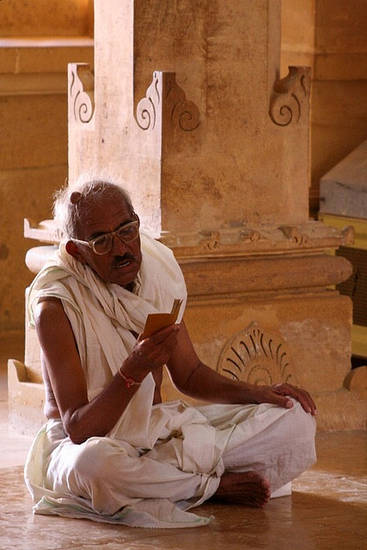
Praying in the temple
Image by nusohotrightnow – Nathaniel Whittemore © CC BY-NC-ND 2.0
Jains have a long history of hymn-writing and hymn-singing. Singing the praises of the Jinas is a key element of worship and forms a crucial part of most religious ceremonies.
Jains regularly sing hymns both solo and in groups, depending on the ritual. In temple rites, groups of singers may perform the sung parts of the ceremony or lead the congregation in a communal hymn. For example, Śankheśvar Dādā is a popular choice of a hymn to sing as a group during Jain liturgical worship. The choirs are usually single sex, their duties differing according to the sex of the members.
Devotional songs are sung at nearly all Jain rites that take place in public, such as renunciation of the householder life. The singers may be family members of the new monk or nun, professional singers or all the worshippers. In private homes, hymns are frequently sung in celebration, generally led by a single singer.
Other hymns are sung only on particular occasions. An example would be the mendicant welcome songs that lay Jains perform to honour ascetics before offering them alms.
Group and solo singing
Jain religious songs are performed routinely as part of the morning worship. The liturgy of the morning worship includes a particular point at which the worshipper is expected to sing a hymn. This is usually sung solo but if a number of Jains performs the daily worship together, they will sing as a group.
As well as the daily prayer ritual, there are other liturgies, such as the Śvetāmbara Snātra Pūjā and Digambara Deva Śāstra Guru Pūjā, in which hymns have a central role. Additional devotional songs are usually also played. These ceremonies are usually communal, with the whole congregation singing hymns. In the sect of the Śvetāmbaras women’s singing groups are also hired to take part in these rituals on behalf of the sponsors.
Many Jain congregations have hymn-singing groups for either men or women. Some larger congregations have both men’s and women’s choirs. These groups sing hymns as a devotional act in a set schedule, but may also be available for hire for celebrations and to perform religious ceremonies. During the evening celebrations the choirs sing hymns but they also may perform veil songs – cunḍaḍī gīt.
On the whole, men’s choirs tend to perform devotional singing for evening celebrations and women’s groups are more likely to take part in the sung liturgies. The musicality of these two groups reflects these different practices. The men’s groups may make more use of amplification and electronic instruments while women’s choirs more usually perform a form of seated percussion dance with similarities to the Gujarāti folk dance genre, garba. Female choirs’ performances tend to be more associated with liturgical ceremonies.
Hymns in public rituals
Major Jain public rituals involve singing hymns. For example, the quintessential public rite of Jainism – the ordination of a Jain monk or nun – is accompanied by ordination songs – dīkṣā gīt. These hymns are sung by:
- members of the renouncer’s family
- professional singers
- the congregation of Jains who have come to participate in the rituals linked with ordination.
Other public rituals such as temple consecrations, festivals and parades associated with mendicants and fasters also include the singing of devotional songs.
Hymns in domestic rituals

Completing a fast
Image by Chandu Shah © Chandu Shah
Some domestic Jain rituals are marked by singing religious songs. These may be specifically Jain rites, such as marking the breaking of a fast, or more broadly auspicious ceremonies, such as the birthday of a more senior relative. In these domestic liturgies, a solo singer leads the hymns and the rest of those present who know the songs join the singing in a call-and-response pattern.
Fast-breaking ceremonies may include performances by an established choir, a group of friends and relatives and individual singers. At these ceremonies fasting songs – tapasya gīt – celebrate the faster’s austerities and virtues. During difficult fasts, these may be sung in the faster’s home in order to support his or her efforts and promote a religious environment to make the fasting easier.
Other hymns and rituals
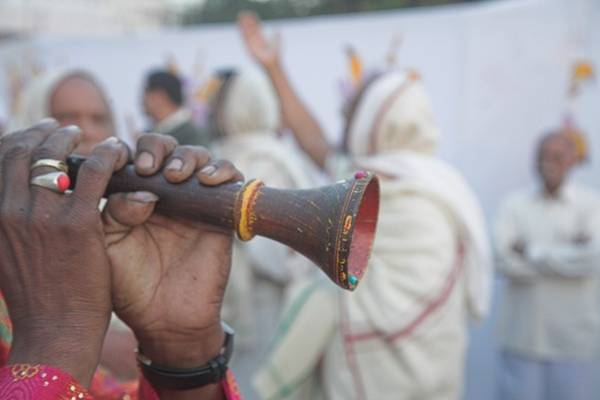
Celebrating initiation
Image by Jayesh Gudka © Jayesh Gudka
Some types of hymns are performed in particular ritual contexts. For example, lay Jains sing mendicant welcome songs – sādhu swāgatam gīt or gahuli gīt – on three specific occasions. Firstly, the hymns salute mendicants when they join a congregation for the rainy season retreat. Secondly, the hymns are sung to honour ascetics before they give a sermon. Thirdly, householder Jains perform these songs before offering food to a mendicant.
Auction songs – boli gīt – are performed during ritual auctions. These take place during Jain festivals and public ceremonies, particularly the festival of Paryuṣaṇ. Ritual auctions are also part of the ceremonies surrounding the renunciation of a new monk or nun.
Reading
- Jains in the World: Religious Values and Ideology in India
John E. Cort - Oxford University Press USA; New York, USA; 2001
- ‘Bhakti in the Early Jain Tradition: Understanding Devotional Religion in South Asia’
John E. Cort - History of Religions
volume 42: 1
University of Chicago Press; 2002
- ‘Singing the Glory of Asceticism: Devotion of Asceticism in Jainism’
John E. Cort - Journal of the American Academy of Religion
volume 70: 4
2002
- The Jaina Path of Purification
Padmanabh S. Jaini - University of California Press; Berkeley, California USA; 1979
- Singing to the Jinas: Jain Laywomen, Maṇḍaḷ Singing and the Negotiations of Jain Devotion
M. Whitney Kelting - Oxford University Press USA; New York, USA; 2001
- ‘On the Ground: Jainism in South India’
Glenn Yocum - Religious Studies News
volume 3: 12
American Academy of Religion; ; 1997
Links
- He Karuṇānā Karaṇārā
-
This recording of He Karuṇānā Karaṇārā on SoundCloud was made by JAINpedia contributor M. Whitney Kelting as part of her fieldwork into Jain devotional practices among Jain women in western India in 2009.
- Look at Śrī Pārśva
-
This recording of Look at Śrī Pārśva on SoundCloud was made by JAINpedia contributor M. Whitney Kelting as part of her fieldwork into Jain devotional practices among Jain women in western India in 2009.
- Śrī Śankheśvar Pārśvanāth
-
This recording of Śrī Śankheśvar Pārśvanāth on SoundCloud was made by JAINpedia contributor M. Whitney Kelting as part of her fieldwork into Jain devotional practices among Jain women in western India in 2009.
http://soundcloud.com/jainpedia/shri-shankheshvar-parshvanath
- Śankheśvar Dādā
-
This recording of Śankheśvar Dādā on SoundCloud was made by JAINpedia contributor M. Whitney Kelting as part of her fieldwork into Jain devotional practices among Jain women in western India in 2009.
- Hymn to Mallinatha
-
This 2007 YouTube video features a Digambara monk singing a hymn – stotra – honouring the 19th Jina, Mallinātha or Lord Malli. The visuals show a Śvetāmbara idol of the Jina over a pulsing, colourful background.
- Candraprabha hymn
-
A recitation on YouTube of a hymn to Candraprabhanātha or Lord Candraprabha, the eighth Jina.
- Devotional song to Candraprabha
-
This 2011 video on YouTube features a hymn praising the eighth Jina, Candraprabhanātha or Lord Candraprabha.
- Hymn to Candraprabha
-
This 2007 YouTube video features a Digambara monk singing a hymn – stotra – honouring the eighth Jina, Candraprabhanātha or Lord Candraprabha. The visuals show a Śvetāmbara idol of the Jina over a pulsing, colourful background.
- Procession of Mahāvīra idol
-
This 2009 YouTube video shows the procession of a small golden idol of Mahāvīra – rathayātrā – through the streets of New Delhi. The procession takes place during the Digambara festival of Daśa-lakṣaṇa-parvan. The men in orange, some of whom are also crowned, are the prominent lay men who have won the privilege of accompanying the statue in the procession. They put the statue in an ornate shrine on a platform set on a tractor with false horses attached. Before the procession begins, Jain lay women move trays of fire in circles – āratī – offering pūja or worship to the idol. Lay people dance in the procession around the idol, which is fanned by fly-whisks, a sign of high status. Many of the dancers wave bright plastic objects, which are modern equivalents of traditional fly-whisks. The women dressed in orange are the wives of the prominent lay men on the tractor. A model of Bāhubali with vines creeping up his legs is also fanned. Small children ride on the shrine, which is hung with a Jain flag at the back, while musicians and models form part of the procession. Two fully fledged monks take part, accompanied by novice monks in white. At the end of the procession the idol is taken into the temple, placed in front of a large Jina image and given a sacred bath. Food is provided for the participants afterwards. All along, there are various songs or prayers. In the first part, the Pañca-namaskāra-mantra is sung to various tunes, then come hymns in Hindi. For instance, one of them says: ‘Listen to the voice of the Jinas’.
- Anointing a Jina statue
-
A statue of a Jina is ceremonially anointed during the festival of Dīvālī, the 'Festival of Lights' which marks the new year. For Jains the main celebration at Dīvālī is the commemoration of the liberation of the 24th Jina, Mahāvīra. A ‘head-anointing ceremony’ – mastakābhiṣeka – is a rite performed for any Jain image. Sanctified fluids are poured over the head of the statue, accompanied by a mantra or hymn. The sacred bath is at the centre of all Jain image rituals and can be performed daily in the morning ceremony or during festivals and pilgrimages. This photo on Flickr was taken in Jodhpur, Rajasthan in October 2009.
- Poṣa-daśamī – part 2
-
Commemorating the birth of the 23rd Jina, Pārśvanātha or Lord Pārśva, the Poṣa-daśamī festival is also known as Pārśvanātha-jayantī. It is celebrated in late December or early January in the Western calendar. Following a street procession – ratha-yātrā – the garlanded statue of Pārśva is brought into the local temple, while a conch is blown and a bell rung. The local community gathers around it and sings hymns in celebration. Chanting, they move a tray of fire in circles, offering pūja or worship to the statue. All the other images of Jinas in the temple are also decorated with flowers.
This two-part YouTube video records the 2010 Poṣa-daśamī festival in Jaipur, Rajasthan as celebrated by Śvetāmbara Jains. This is the last part.
http://www.youtube.com/watch?v=vXsnBlBDOHk
https://www.youtube.com/watch?v=UddsDpAwYAY
- Head anointing ceremony
-
The Huntington Archive at Ohio State University provides a photograph of devotees anointing a smaller image at the foot of the large statue of Bāhubali at Shravana Belgola in Karnataka. In this 2001 photo, the pilgrims are performing a ‘head-anointing ceremony’ – mastakābhiṣeka – of a small image of Bāhubali. This rite can be carried out for any Jain image and involves pouring consecrated liquids over the head, accompanied by a mantra or hymn. The sacred bath is at the centre of all Jain image rituals and can be performed daily in the morning ceremony or during festivals and pilgrimages.
http://huntington.wmc.ohio-state.edu/public/index.cfm?fuseaction=showThisDetail&ObjectID=30021938
- Hymn to Ṛṣabha
-
This hymn on YouTube is dedicated to Ṛṣabhanātha or Lord Ṛṣabha, the first of the 24 Jinas of this era of time. The slideshow has pictures of devotees praying to Ṛṣabha and passing on his teachings.
- Namaskāra-mantra and Bhaktāmara-stotra with yantras – part one
-
This YouTube slideshow features a recording of the Namaskāra-mantra followed by the Bhaktāmara-stotra, a famous Sanskrit hymn of praise to the first Jina, Ṛṣabha.;
Also known as the Navkār-mantra or Namokār-mantra, the Namaskāra-mantra is a very old mantra in Prakrit. It can be sung to different tunes and is chanted daily to honour the 'five types of beings worthy of worship' or Supreme Beings':
Bhaktāmara-stotra means Devoted Gods. This title comes from the first verse, which describes how all the gods offer homage to Ṛṣabha. The slideshow includes colour-tinted yantras and mantras to help listeners meditate.
This is the first of four parts of the Śvetāmbara hymn, which has 44 verses. This part contains stanzas 1 to 12.
http://www.youtube.com/watch?v=ZzJtiikKnh4
This YouTube slideshow features a recording of the Bhaktāmara-stotra, a famous Sanskrit hymn of praise to the first Jina, Ṛṣabha. The title Devoted Gods comes from the first verse, which describes how all the gods offer homage to Ṛṣabha. The slideshow includes colour-tinted yantras and mantras to help listeners meditate.
This is the first of four parts of the 44-verse Śvetāmbara hymn, covering stanzas 01 to 12
https://www.youtube.com/watch?v=ZzJtiikKnh4&list=PLE8A9751AC19A4277
- Bhaktāmara-stotra with yantras – part two
-
This YouTube slideshow features a recording of the Bhaktāmara-stotra, a famous Sanskrit hymn of praise to the first Jina, Ṛṣabha. The title Devoted Gods comes from the first verse, which describes how all the gods offer homage to Ṛṣabha. The slideshow includes colour-tinted yantras and mantras to help listeners meditate.
This is the second of four parts of the 44-verse Śvetāmbara hymn, covering stanzas 13 to 25.
- Bhaktāmara-stotra with yantras – part three
-
This YouTube slideshow features a recording of the Bhaktāmara-stotra, a famous Sanskrit hymn of praise to the first Jina, Ṛṣabha. The title Devoted Gods comes from the first verse, which describes how all the gods offer homage to Ṛṣabha. The slideshow includes colour-tinted yantras and mantras to help listeners meditate. The yantras in this part begin with the svastika, ancient Asian symbol of well-being and good fortune.
This is the third of four parts of the 44-verse Śvetāmbara hymn, covering stanzas 26 to 38.
- Bhaktāmara-stotra with yantras – part four
-
This YouTube slideshow features a recording of the Bhaktāmara-stotra, a famous Sanskrit hymn of praise to the first Jina, Ṛṣabha. The title Devoted Gods comes from the first verse, which describes how all the gods offer homage to Ṛṣabha. The slideshow includes colour-tinted yantras and mantras to help listeners meditate.
This is the last of four parts of the 44-verse Śvetāmbara hymn, covering stanzas 39 to 44.
- Hymn to Naminātha
-
This 2007 hymn on YouTube is a Sanskrit stotra to the 21st Jina, Naminātha or Lord Nami. The sound is accompanied by pictures of statues of Jinas and monks of various Jain sects. The plain statues of nude Jinas with closed eyes and the naked monks belong to Digambara sects. The white-robed mendicants are Śvetāmbara Mūrtipūjakas. The monks and nuns with mouth-cloths attached to their ears are from either the Terāpanthin or Sthānaka-vāsīn Śvetāmbara sects.
- Praise of the Jinas
-
This 2010 YouTube video features a rendition of a hymn to the Jinas, sung in Gujarati. A stuti is an old prayer, usually in Prakrit or Apabhraṁśa, that can be either chanted or recited.
- Song versions of the Ātmasiddhi
-
One of the most influential works of the 19th-century poet and mystic Śrīmad Rājacandra is the Ātmasiddhi (Realisation of the Self). The Atmadharma website offers MP3 audio files of different singers singing the Ātmasiddhi in the original Gujarati and in Hindi. In the traditional bhakti devotional style, the music can be downloaded or listened to online.
http://www.atmadharma.com/audio/bhakti/atmasiddhishastra.html
- Śruta-pañcamī – part 1
-
Some features of the annual Digambara festival of knowledge – Śruta-pañcamī – are demonstrated in this YouTube video, such as the worship ritual and the procession of holy texts. Temple rites include the ritual anointment of freestanding metal plaques representing holy texts and idols, accompanied by jangling percussion. The main part of the ritual shown in this video centres around the worship of the śruta-skandha-yantra, a plaque made of brass in the form of a tree, which represents the kinds of scriptures Digambaras recognise. Carried in procession, the sacred books are garlanded with flowers and flanked by attendants using fly-whisks, which indicate the princely status of the artefacts, while devotees kneel before a naked monk and touch his feet. The Ṣaṭkhaṇḍāgama, the main authoritative source of Digambara teachings, is the book worshipped here.
This three-part YouTube video records the festival at Mudalur, Tamil Nadu in India, held over 28th and 29th May 2009. This is the first part and you can watch the second part at: http://www.youtube.com/watch?v=M-I9AYjIcAc
- Śruta-pañcamī – part 2
-
The procession of holy texts in the annual Digambara festival of knowledge – Śruta-pañcamī – is the main subject of this YouTube video. As the centre of festivities, the sacred books are decorated with flower garlands. They are placed on a model elephant, protected from the sun by a canopy and fanned with fly-whisks, all symbols of royalty. The Jain flag is waved in front. Lay Jains, many dressed in orange – the colour of spirituality in India – take part in the noisy procession. Some carry the metal sculptures of the 12 dreams of a Jina’s birth. A nude monk, holding his peacock-feather broom, and white-clad nuns also participate. The procession ends with a display of holy books, the reflection of which is ritually anointed, and a rite of worship in which the auspicious symbol of the svastika can be clearly seen.
This three-part YouTube video records the festival at Mudalur, Tamil Nadu in India, held over 28th and 29th May 2009. This is the second part and you can watch the last part at: http://www.youtube.com/watch?v=zR21K-vcp5U
- Śruta-pañcamī – part 3
-
This YouTube video follows the end of the first day’s events of the annual Digambara festival of knowledge – Śruta-pañcamī. First, a rite of worship before a brightly coloured rangoli – a design of coloured powder or rice symbolising joy and welcome – is performed. The lay community files past the rangoli and metal sculpture representing knowledge while monks and lay people chant a Sanskrit hymn. This song praises knowledge, omniscience, the scriptures and the goddess Sarasvatī, who embodies knowledge. Behind the rangoli piles of holy books can be seen, which have been carried in procession through the village as guides to knowledge. After the fire ritual, an inititation ceremony – dīkṣā – of a new monk, featuring keśa-loca – ‘pulling out of the hair’ – takes place before the crowd. Afterwards, they move trays of fire in circles – āratī – offering pūja or worship to the new mendicant. An anointing ceremony – abhiṣeka – of the māna-stambha pillar found in front of Jain temples follows, with a final procession past the symbols of knowledge.
This three-part YouTube video records the festival at Mudalur, Tamil Nadu in India, held over 28th and 29th May 2009. This is the final part and you can watch the first part at: http://www.youtube.com/watch?v=5S2bcehoy-U
- Jain mantras
-
This 2007 animation from YouTube features a Digambara monk singing the fundamental Jain sacred formulas. The second is the Namaskāra-mantra, also called the Navkār-mantra or Namokār-mantra. A very old mantra in Prakrit, it can be sung to various melodies. It is chanted daily to the 'five types of beings worthy of worship' or Supreme Beings':
- enlightened teachers – Arhats or Jinas
- liberated souls – siddhas
- mendicant leaders – ācāryas
- teachers – upādhyāyas
- mendicants – sādhus.
Then comes a short mantra about the emptiness of the world of rebirths and the celebration of the 'four auspicious things' or 'four refuges':
- Arhat
- siddha
- monks
- law – dharma.
- +
- aAbhavya
- aAbhinandana
- aAbhiṣeka
- aĀcāra
- aĀcārāṅga-sūtra
- aĀcārya
- aAchalbhrata
- aAḍhāī-dvīpa
- aAdharma
- aAdho-loka
- aAdhyayana
- aAdvaita Vedānta
- aĀgama
- aAghātīya
- aAghātīya-karman
- aAgnibhuti
- aAgra
- aĀhāra
- aAhiṃsā
- aAhimsa Day
- aAjita
- aAjīva
- aAkampit
- aĀkāśa
- aAkbar the Great
- aAkṣaya-tṛtīyā
- aAlauddin Khalji
- aAlbert Einstein
- aAllah
- aAlms
- aĀlocanā
- aAloka-ākāśa
- aAmāri
- aAmbikā or Kūṣmāṇḍinī
- aAnagāra
- aAnanta
- aAnarthadaṇḍa
- aAnaśana
- aAnekānta-vāda
- aAṅga
- aAniconism
- aAnojjā
- aAntarāla
- aAntarāya-karma
- aAṇu
- aAṇu-vrata
- aAnukampā
- aAnuprekṣā
- aAnusvāra
- aApabhraṃśa
- aAparigraha
- aAra
- aĀrambha
- aĀrambhaja
- aĀratī
- aArdhamāgadhī Prākrit
- aArhaṃ
- aArhat
- aArśana-āvaraṇīya-karma
- aĀrta-dhyāna
- aĀryikā
- aĀryikā Jñānamati
- aĀśātanā
- aĀścarya
- aAscetic
- aAsceticism
- aAshram
- aAspiration
- aĀsrava
- aAṣṭa-maṅgala
- aAṣṭāpada
- aAstikāya
- aAstrolabe
- aAsura
- aAtheism
- aAticāra
- aAtiśayakṣetra
- aAtithisaṃvibhāgavrata
- aĀtma-vāda
- aĀtman
- aAuṃ
- aAurangzeb
- aAuspicious
- aAusterity
- aAvadhāna
- aAvadhi-jñāna
- aĀvaraṇī-yakarman
- aAvasarpiṇī
- aAvatāra
- aAvidyā
- aAxiom
- aĀyāga-paṭa
- aĀyambil
- aĀyu-karma
- aĀyurveda
- bBabur
- bBāhubali
- bBaladeva
- bBālāvabodha
- bBandha
- bBasadi
- bBazaar
- bBhadrankarvijay
- bBhagavant
- bBhaktāmara-stotra
- bBhakti
- bBhale
- bBharata
- bBhāṣā
- bBhāṣya
- bBhaṭṭāraka
- bBhāva
- bBhāva-pūjā
- bBhāvanā
- bBhavana-vāsin
- bBhavya
- bBhavyatva
- bBhaya
- bBhoga-bhūmi
- bBhogopabhoga
- bBodhi
- bBollywood
- bBrahmā
- bBrahma-deva
- bBrahmacārī
- bBrāhmaṇa
- bBraj Bhāṣā
- bBright fortnight
- bBritish Raj
- bBuddha
- bBuddhi-sagar
- bBuddhism
- bBuddhist
- cCaitya
- cCaityavāsin
- cCakravartin
- cCakreśvarī
- cCāmara
- cCandanā
- cCandragupta
- cCandraprabha
- cCanon
- cCāritra
- cCāritramohanīya-karman
- cCarũrī
- cCaste
- cCaturvidha-saṅgha
- cCaturviṃśati-stava
- cCāturyāma
- cCE
- cCelibacy
- cCha
- cChadmastha
- cChastity
- cCheda-sūtra
- cChristian
- cChristianity
- cClergy
- cCloning
- cColophon
- cCommentary
- cConch
- cConfession
- cCongregation
- cConsecration
- cCosmology
- cCremation
- cCrore
- cCult
- cCūrṇi
- dDādā-guru
- dDalit
- dDāna
- dDaṇḍa
- dDark fortnight
- dDarśana
- dDarśanamohanī-yakarman
- dDaśa-lakṣaṇa-parvan
- dDeity
- dDelhi Sultanate
- dDerāsar
- dDeśāvakāśika-vrata
- dDetachment
- dDevanāgarī
- dDevānandā
- dDevarddhi-gani
- dDevotee
- dDhamal
- dDhanuṣ
- dDhāra
- dDharma
- dDharma-dhyāna
- dDharma-sāgara
- dDharmastikaya
- dDhātakīkhaṇḍa
- dDholak
- dDhyāna
- dDiaspora
- dDig-vrata
- dDigambara
- dDīkṣā
- dDisciple
- dDīvālī
- dDivya-dhvani
- dDNA
- dDoctrine
- dDogma
- dDonor
- dDoṣa
- dDravya
- dDravya-pūjā
- dDrone
- dDuṣamā
- dDuṣamā-duṣamā
- dDuṣamā-suṣamā
- dDveṣa
- dDvīpa
- eEast India Company
- eEightfold Path
- eEkānta-vāda
- eEkendriya
- eElder
- eElders
- eEschatology
- eEtc up to
- fFarmān
- fFast
- fFatehpur Sikri
- fFestival
- fFestschrift
- fFiruz Shah
- fFly-Whisks
- fFolio
- fFour Noble Truths
- gGaccha
- gGaṇa
- gGaṇadhara
- gGanadharavada
- gGaṇeśa
- gGaṇin
- gGarba
- gGarbha
- gGarbha-gṛha
- gGaruḍa
- gGati
- gGene
- gGenomics
- gGhātī-yakarman
- gGhātīya
- gGhaznavid
- gGhiyasuddin Tughlaq
- gGhurid
- gGloss
- gGotra-karma
- gGujarāt
- gGujarati
- gGuṇa
- gGuṇa-sthāna
- gGuṇa-vrata
- gGupti
- gGuru
- gGuruṇī
- hHagiography
- hHajj
- hHaṃsa
- hHaribhadra
- hHariṇaigameṣin
- hHasta
- hHeresy
- hHiṃsā
- hHindi
- hHindu
- hHinduism
- hHīravijaya
- hHoroscope
- hHrīṃ
- hHumayun
- hHymn
- iIconoclasm
- iIconography
- iIdol
- iIndian Independence
- iIndology
- iIndra
- iIndrabhūti Gautama
- iIndriya
- iInitiation
- iIntercession
- iInvocation
- iIQ
- iIslam
- iIslamicate
- iIṣṭadevatā
- iĪśvara
- jJagat
- jJahangir
- jJain
- jJaina Devanāgarī
- jJaina Śaurasenī
- jJaina-dharma
- jJainaśāsana
- jJainness
- jJaisalmer
- jJamāli
- jJambū-dvīpa
- jJames Burgess
- jJanma
- jJanma-kalyāṇa
- jJarā
- jJāti
- jJina
- jJina-āgama
- jJina-bhavana
- jJina-bimba
- jJina-mātā
- jJinacandra-sūri
- jJinadatta
- jJinaprabha
- jJīva
- jJñāna
- jJñāna-āvaraṇīya-karma
- jJñāna-āvarṇiya
- jJñānsundar
- jJyotiṣka
- kKāla
- kKālakācārya-kathā
- kKālidāsa
- kKalpa-sūtra
- kKalpa-vṛkṣa
- kKalyāṇaka
- kKalyanvijay
- kKamaṇḍalu
- kKamaṭha
- kKarma
- kKarma-bhūmi
- kKarma-grantha
- kKarma-prakṛti
- kKarma-vāda
- kKarmon
- kKarnataka
- kKaṣāya
- kKathā
- kKāvya
- kKāya
- kKāyotsarga
- kKeśa-loca
- kKetu
- kKevala-jñāna
- kKevalin
- kKhalji
- kKharatara-gaccha
- kKnowledge
- kKriyā
- kKriyā-vāda
- kKṛṣṇa
- kKṣamā-śramaṇa
- kKṣapakaśreṇi
- kKṣatriya
- kKṣullaka
- kKulakara
- kKundakunda
- kKunthu
- lLabdhi
- lLaity
- lLakh
- lLāñchana
- lLands of Action
- lLaukāntika
- lLavaṇa-samudra
- lLeśyā
- lLiṅga
- lLinguistics
- lLoka
- lLoka-ākāśa
- lLoka-puruṣa
- lLoka-vāda
- lLotus
- lLotus lake
- mMadhya-loka
- mMahā-videha
- mMahā-vrata
- mMahābhārata
- mMahāmastakābhiṣeka
- mMāhārāṣṭra
- mMāhārāṣṭrī Prākrit
- mMahattarā Yākinī
- mMahāvīr Jayantī
- mMahāvīra
- mMakāra
- mMakkhali Gośāla
- mMalli
- mMāna-stambha
- mManaḥ-paryāya-jñāna
- mMaṇḍala
- mMaṇḍapa
- mMandit
- mMaṅgala
- mMantra
- mMantras
- mManuṣya-loka
- mMarāṭhī
- mMārgaṇā
- mMartyr
- mMarudevī
- mMaṭha
- mMati-jñāna
- mMauryaputra
- mMecca
- mMendicant lineage
- mMetarya
- mMiracle
- mMithyādṛṣṭi
- mMohandas Gandhi
- mMohanīya-karma
- mMokṣa
- mMonastic order
- mMonasticism
- mMonk
- mMonotheism
- mMosque
- mMount Meru
- mMount Sammeta
- mMṛgāvatī
- mMughal
- mMuhammad
- mMuhammad bin Tughlaq
- mMuhpattī
- mMūla-sūtra
- mMūlaguṇa
- mMumbaī
- mMuni
- mMunisuvrata
- mMurad Bakhsh
- mMūrti-pūjaka
- mMuslim
- mMysticism
- nNābhi
- nNāga-kal
- nNāgapurīya Tapā-gaccha
- nNāgarī
- nNāma-karma
- nNamaskāra-mantra
- nNami
- nNandīśvara-dvīpa
- nNandivardhana
- nNandyāvarta
- nNāraka
- nNāraki
- nNasalisation
- nNātha
- nNavrātrī
- nNaya-vāda
- nNemi
- nNidāna
- nniggaṃthāṇa vā 2
- nniggaṃtho vā 2
- nNigoda
- nNihnava
- nNikṣepa
- nNirgrantha
- nNirjarā
- nNirvāṇa
- nNiryukti
- nNiṣidhi
- nNitya
- nNiyati
- nNo-kaṣāya
- nNudity
- nNun
- oOcean of milk
- oOmniscience
- oOrdination
- ppa°
- pPadmaprabha
- pPadmāsana
- pPadmāvatī
- pPādukā
- pPalanquin
- pPalette
- pPañca-muṣṭi
- pPāṇḍava
- pPaṇḍit
- pPandit Dalsukh D. Malvania
- pPandit Sukhlalji
- pPāṇipātra
- pPāpa
- pParamātman
- pParameṣṭhin
- pPāraṇā
- pParigraha
- pPariṇāma
- pParīṣaha
- pParokṣa
- pPārśva
- pPārśvanātha
- pParyāya
- pParyuṣaṇ
- pPaṭa
- pPatan
- pPātra
- pPenance
- pPersian
- pPhala
- pPhilology
- pPicchikā
- pPilgrimage
- pPīr
- pPolymath
- pPoṣadha
- pPossession
- pPothī
- pPrabhas
- pPradakṣiṇā
- pPradeśa
- pPrākāra
- pPrakīrṇaka-sūtra
- pPrākrit
- pPramāda
- pPramukhā
- pPrati-vāsudeva
- pPratikramaṇa
- pPratimā
- pPratiṣṭhā
- pPratyākhyāna
- pPratyakṣa
- pPravacana
- pPrāyaścitta
- pPrayer
- pPre-modern
- pPreach
- pPredestination
- pProtestant
- pProvenance
- pPudgala
- pPūjā
- pPujārī
- pPukharavara-dvīpa
- pPuṇya
- pPūrva
- pPuṣkara-dvīpa
- pPuṣpadanta
- pPyre
- qQur’an
- rRāga
- rRāhu
- rRainy season
- rRajasthan
- rRajasthani
- rRājimatī
- rRajoharaṇa
- rRajput
- rRāma
- rRāmāyaṇa
- rRangoli
- rRās-garbā
- rRasa
- rRathanemi
- rRatna-traya
- rRātri-bhojana
- rRaudra-dhyāna
- rRecto
- rRelic
- rRenunciation
- rRetroflex
- rRevatī
- %Ṛg-veda
- rRite
- rRosary
- %Ṛṣabha
- %Ṛṣabhanātha
- rRupee
- sSaciyā Mātā
- sSādhu
- sSādhvī
- sSāgāra
- sSaint
- sŚaivaism
- sŚaka-saṃvat
- sSallekhanā
- sŚalya
- sSamacatuṣṭha
- sSamādhimaraṇa
- sSamaṇi
- sSāmarambha
- sSamavasaraṇa
- sSāmāyika
- sSaṃbhava
- sSamiti
- sSaṃjñā
- sSaṃkalpaja
- sSaṃsāra
- sSamudghāta
- sSaṃvara
- sSaṃvega
- sSamyak-cāritra
- sSamyak-darśana
- sSamyak-jñāna
- sSamyaktva
- sSaṃyama
- sSanctuary
- sSandalwood
- sSaṇgha
- sSanskrit
- sSant
- sŚānti
- sSapta-bhaṅgi-naya
- sSārambha
- sSarasvatī
- sSarvajña
- sSāsan-devi
- sŚāsana-devatā
- sŚāstra
- %Ṣaṭ-jīvanikāya
- sSatī
- sSatīmātā
- sSatya
- sSchism
- sScribe
- sScripture
- sSect
- sSecularism
- sŚenāī
- sSermon
- sŚeṣavatī
- sSevā
- sSeven fields of donation
- sShah Jahan
- sShantidas Jhaveri
- sShrine
- sSiddha
- sSiddha-śilā
- sSiddhacakra or Navadevatā
- sSiddhānta
- sSiddhārtha
- sSiddhi
- sSikh
- sSikhism
- sŚikṣā-vrata
- sŚīla
- sSin
- sSindh
- sŚītala
- sŚiva
- sSkandha
- sSomanatha
- sŚraddhā
- sŚramaṇa
- sŚrāvaka
- sŚrāvakācāra
- sŚrāvikā
- sŚreyāṃsa
- sŚrī
- sŚrīvatsa
- sŚruta-jñāna
- sŚruta-pañcamī
- sSthānaka-vāsin
- sSthāpanācārya
- sSthāvara
- sSthavira
- sSthiti
- sStrīmukti
- sStūpa
- sSubcontinent
- sSudarshana
- sŚuddhi
- sSudharma
- sŚūdra
- sSufism
- sSukha
- sŚukla-dhyāna
- sSulasā
- sSultan
- sSumati
- sSundarśrī
- sSupārśva
- sSūri
- sSuṣamā
- sSuṣamā-duṣamā
- sSuṣamā-suṣamā
- sSūtra
- sSuyam me ausam! Tenam bhagavaya evamakkhayam
- sSvādhyāya
- sSvāhā
- sSvastika
- sŚvetāmbara
- sŚvetāmbara Terāpanthin
- sŚvetāmbaras
- sSwan
- sSyād-vāda
- tTabla
- tTantra
- tTapā-gaccha
- tTapas
- tTāraṇ Svāmī Panth
- tTattva
- tTattvārtha-sūtra
- tTemple
- tTemple-city
- tThe Enlightenment
- tTheology
- tThree worlds
- %Ṭīkā
- tTilaka
- tTīrtha
- tTīrthaṃkaranāma-karman
- tTīrthankara
- tTransliteration
- tTrasa
- tTrasa-nāḍī
- tTriśalā
- tTriṣaṣṭi-śalākā-puruṣa-caritra
- tTti bemi
- tTughlaq
- tTunk
- uUdumbara
- uUniversal History
- uUpādhyāya
- uUpāṅga
- uUpaniṣads
- uUpāsaka
- uUpasarga
- uUpāśraya
- uŪrdhva-loka
- uUtsarpiṇī
- uUttarādhyayana-sūtra
- vVāhana
- vVaimānika
- vVairāgya
- vVaiṣṇava
- vVaiśramaṇa
- vVaiśya
- vValabhī
- vVanaspatikāya
- vVandana
- vVaṇik
- vVarṇa
- vVāsudeva
- vVāsupūjya
- vVayubhūti
- vVeda
- vVedanīya-karma
- vVegetarianism
- vVehicle
- vVernacular
- vVerso
- vVidyā
- vVidyā-devī
- vVihāra
- vVijñapti-patra
- vVikrama-saṃvat
- vVikṛti
- vVimala
- vVinaya
- vVipāka
- vVirji Vora
- vVirodhaja
- vVīrya
- vVisarga
- vViṣṇu
- vVītarāga
- vVizier
- vVotive
- vVow
- vVrata
- vVS
- vVyakta
- vVyantara
- vVyasana
- yYakṣa
- yYakṣī
- yYantra
- yYaśoda
- yYaśovijaya
- yYati
- yYātrā
- yYoga
- yYoginī
- yYojana



